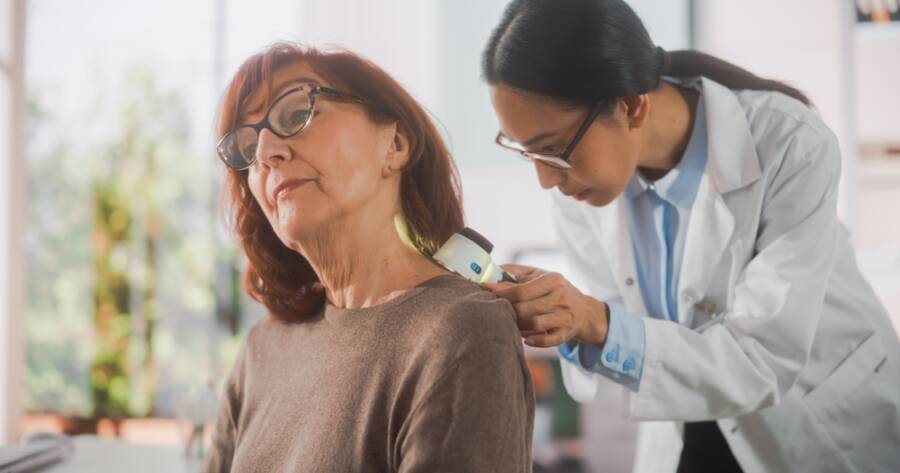Skin cancer, the most prevalent cancer in the U.S., encompasses types like nonmelanoma (squamous and basal cell carcinoma) and the more aggressive melanoma. Early detection is vital, using methods such as self-exams and dermatoscopy. Treatment ranges from surgical interventions to systemic therapies, underscoring the importance of prevention, awareness, and comprehensive care strategies.
Skin Cancer Types and How to Detect Them
Skin cancer is the most common form of cancer in the United States, affecting millions each year. It is broadly categorized into two types: nonmelanoma and melanoma. Nonmelanoma includes squamous cell carcinoma and basal cell carcinoma, both prevalent among individuals exposed to UV radiation. Melanoma, although less common, is significantly more dangerous due to its ability to spread rapidly to other parts of the body and has various stages, with higher numbers indicating more advanced disease. Regular self-examinations are crucial for early detection, allowing individuals to monitor for new growths or changes in existing moles.
Early detection of skin cancer involves multiple methods, including visual exams and dermatoscopy, which help differentiate between benign and malignant lesions, leading to early diagnosis. Dermatologists might use tools like dermatoscopes for a magnified view or employ advanced technologies such as total body photography to monitor skin changes over time. Skin biopsy, a standard procedure, involves taking a skin sample for microscopic examination to confirm the diagnosis.
Recognizing the Signs: How to Detect Skin Cancer
Recognizing skin cancer signs involves understanding the different characteristics that lesions may present. It’s important to look out for asymmetry, border irregularities, color changes, diameter larger than 6mm, and evolving elements of moles or skin lesions. Screening tests for skin cancer are increasingly utilizing artificial intelligence to improve diagnostic accuracy and speed by analyzing lesion images. However, even with advanced methods, false-positive and false-negative results can occur, which may lead to unnecessary anxiety or delays in receiving medical care.
While clinical trials are ongoing to evaluate new screening tests’ efficacy, current methods largely rely on visual and biopsy-based confirmation. For comprehensive detection, individuals should consider regular professional skin examinations, especially those with a history of skin cancer or numerous moles.
Treatment Options for Skin Cancer
Skin cancer treatment largely depends on the type and stage of the cancer. Localized treatment options for lower-stage cancers include procedures like curettage and electrodessication, Mohs surgery, or simple excisions that aim to remove cancerous tissues while preserving healthy skin. This precise surgical excision method is particularly beneficial for reducing recurrence and minimizing scarring.
Advanced therapies for progressed skin cancer cases involve systemic treatments such as chemotherapy, radiation therapy, targeted therapy, and immunotherapy. These are often complemented by molecular and genetic testing, which may guide personalized treatment plans, particularly in cases of melanoma that exhibit specific genetic markers such as BRAF mutations.
Managing Side Effects and Recovery
Post-treatment recovery can vary widely based on the method employed. Surgical interventions might require simple wound care or more extended recovery periods if more invasive techniques are used. Side effects from systemic treatments may include fatigue, nausea, or skin irritation, necessitating supportive care measures. Regular follow-ups are vital to monitor recovery and adjust treatment plans as necessary.
Healthcare professionals can provide guidelines on managing side effects and maintaining a healthy lifestyle post-treatment. This often involves engaging in physical therapy, nutritional guidance, and mental health support to optimize cancer recovery and overall well-being.
Prevention and Long-Term Skin Health
Prevention of skin cancer primarily revolves around reducing UV exposure. This includes using sunscreen, wearing protective clothing, and avoiding tanning beds. Public awareness campaigns emphasize the importance of regular skin self-examinations and professional screenings to detect and treat skin issues early.
Long-term skin health can be supported by adopting habits such as maintaining a healthy diet rich in antioxidants, staying hydrated, and following skin care routines tailored to individual needs. A preventive mindset not only reduces the risk of skin cancer but also improves overall dermatological health.
Learn More About Skin Cancer
Understanding skin cancer’s various types and detection methods is pivotal for effective prevention and treatment. With millions affected, awareness about early detection strategies can save lives, ensuring timely medical intervention. Exploring skin cancer treatment options helps individuals and families make informed healthcare decisions.
As research continues to evolve, staying informed about the latest diagnostics and treatment technologies can enhance outcomes significantly. Healthy lifestyle choices and proactive skin care can reduce risk factors, fostering a foundation for long-term health. By educating oneself on skin cancer, individuals can contribute to not only their health but also raise awareness within their communities, advocating for better prevention and management strategies.
Sources
Skin Cancer Overview and Screening





